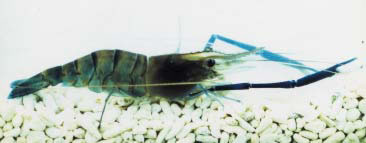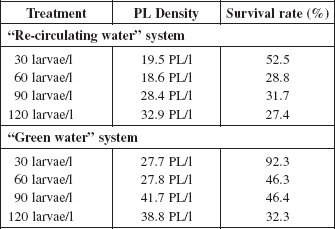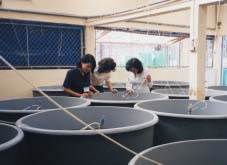Development of freshwater prawn seed production technology suitable for use in the Mekong Delta region of Vietnam
Description
[Objectives]
The giant freshwater prawn, Macrobrachium rosenbergii (Fig. 1), has been pinpointed by the Vietnamese Government as one of the major target species of the aquaculture sector. Until the beginning of 2000, the supply of hatchery reared M. rosenbergii depended on a few previously established national hatcheries, and did not meet the growing needs of commercial prawn culture. Recognizing this problem as a major factor limiting the development of M. rosenbergii culture in the Mekong Delta, JIRCAS and Vietnam's Cantho University initiated collaborative research in 1995.
[Results]
The "green water" and the "re-circulating water" models of seed production were initially compared. Densities of 60 to 120 larvae per liter were recommended for both models, but the "green water" model yielded more post-larvae (PL) per liter, varying from 27.8-41.7 PL/liter compared with 18.6-32.9 PL/liter for the "recirculating water" model (Table 1). Moreover, the "green water" model requires less labor, and is easier to implement in "back-yard" hatching facilities that are likely to be adopted by farmers engaging in prawn-rice culture (Cantho University's mini-hatchery shown in Fig. 2). Based on these results, a modified static "green water system" suitable for the conditions of seed production in the Mekong Delta was developed. In this system, super-saturated seawater from salt fields in the southernmost coastal parts of the Mekong Delta and freshwater are mixed in appropriate quantities to obtain the desired salinity concentration, and the water is treated for several days with chlorine. Next, in order to create "green water", tilapia are stocked for a week in a separate tank to create an environment where planktonic algae bloom and the water turns green. Chlorella is obtained selectively by filtration, and the water is then transferred to tanks to be used for prawn seed production. After larval prawn hatch, they are reared for nearly 30 days without the exchange of water until they metamorphose into post-larvae. Since the beginning of 2000, the "green water" model has been introduced to various users (including provincial authorities and the private sector), and the number of hatcheries and quantity of post-larvae produced rapidly increased. In fact, the production of post-larvae reached over fifty million by the end of 2001 or about 50-fold compared to the 1990s.
Figure, table
-
Fig. 1. The target species, the giant freshwater prawn, Macrobrachium rosenbergii. -
Table 1. Survival rates of larvae and final number of postlarvae (PL) produced under the “re-circulating water” and “green water” systems.
-
Fig. 2. Cantho University’s mini-hatchery.
- Affiliation
-
Japan International Research Center for Agricultural Sciences Fisheries Division
- Term of research
-
FY2002 (FY1999-2003)
- Responsible researcher
-
WILDER Marcy Nicole ( Fisheries Division )
ORCID ID0000-0003-2114-2000KAKEN Researcher No.: 70360394PHUONG Nguyen Thanh ( Can Tho University )
HIEN Tra Thi Thanh ( Can Tho University )
HAI Ngoc Tran ( Can Tho University )
HUONG Do Thi Thanh ( Can Tho University )
- ほか
- Publication, etc.
-
Huong, D. T. T., Jayasankar, V., Jasmani, S., Saido-Sakanaka, H., Wigginton, A. and Wilder, M. N. (2002): Na/KATPase activity during larval development in the giant freshwater prawn, Macrobrachium rosenbergii and the effects of salinity on survival rates. Fisheries Science (in press).
Wilder, M. N. and Fukuda, Y. (2002): Development of freshwater prawn seed production technology in the Mekong Delta region of Vietnam. Yoshoku (Aquaculture Monthly), 39, 98-101 (in Japanese).
- Japanese PDF
-
2002_20_A3_ja.pdf968.48 KB
- English PDF
-
2002_20_A4_en.pdf61.22 KB



